Foreign News
World’s largest crocodile in captivity dies
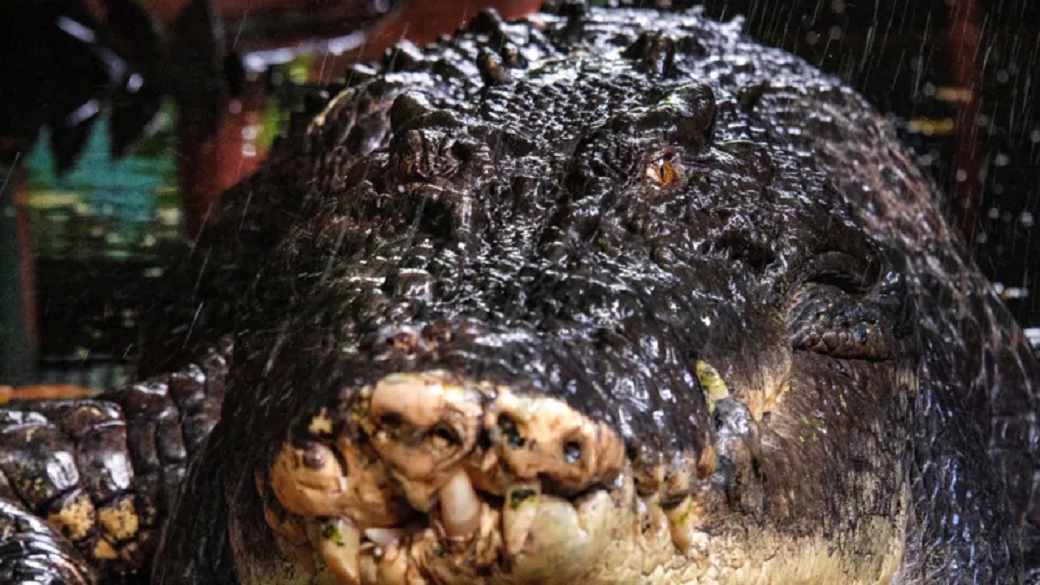
The world’s largest crocodile in captivity has died at a wildlife sanctuary in Australia.
Cassius was nearly 5.5m (18ft) long, weighed nearly one tonne and was thought to be at least 110 years old – although no one knew for sure.
The huge saltwater crocodile lived in the sanctuary on an island off the coast of Queensland since being caught in Australia’s Northern Territory in the 1980s.
In 2011, he was awarded the Guinness World Record for the largest crocodile in captivity.
Marineland Melanesia Crocodile Habitat said in a post on social media that Cassius was “our beloved mate” and “a cherished member of our family”.
Cassius had previously lived in the wild, where he was known for catching and eating cattle, and attacking boat propellers before being captured.
The habitat’s founder, George Craig, bought Cassius in 1987, the Australian Broadcasting Corporation reported.
Cassius “brought joy and companionship to his best mate George for over 37 years”, the habitat said.
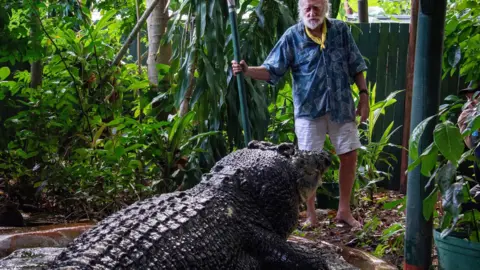
[BBC]
Foreign News
British man killed by president’s convoy in Kenya hit-and-run

A British man has been killed in a hit-and-run incident involving a vehicle in the motorcade of Kenyan President William Ruto.
The man, who has been named as 79-year-old Edgar Charles Frederick, died on Thursday after being struck in the accident on a main road in the capital, Nairobi.
Police detained a driver, who has since been released on bail.
They say he was driving a support vehicle that was travelling as part of President Ruto’s official convoy of cars.
Police spokesman Michael Muchiri told the BBC that Mr Frederick had been visiting Kenya to see his sister and nephew who are residents of the country.
The victim’s next-of-kin have been informed, and a post-mortem is likely to be conducted later on Friday.
The police said the driver, who failed to stop after the incident, would appear in court following an investigation.
A spokesperson for the UK High Commission said officials were aware of the reports and were seeking more information.
Videos posted on social media show a man in blue jeans and a light-coloured shirt lying bleeding on the road outside a busy shopping area.
Other pictures show the victim covered in a checked shawl, known locally as a Maasai Shuka.
Mr Muchiri told the BBC the vehicle belonged to the regional administration and was providing support to the presidential detail.
President Ruto held events in the vicinity of the scene on Thursday as part of ongoing political engagements with the public in the capital.
[BBC]
Foreign News
Hotpot chain compensates diners after teenagers urinate in soup

China’s biggest hotpot chain Haidilao has offered to compensate more than 4,000 diners who visited one of its Shanghai branches, where two teens urinated into their hotpot broth.
A video of the boys peeing into their broth pot while dining in a private room was widely shared online last month. It is not clear who might have filmed the incident.
Police said the 17-year-olds, who were drunk at the time, were detained soon after the incident.
There is no suggestion anyone consumed the affected broth. Haidilao has apologised to customers, saying it has replaced all hotpot equipment and dining utensils, as well as disinfecting other crockery and utensils.
The incident happened late in February, though the company’s management only found out about it days later, after videos circulated on social media.
Haidilao said the staff on duty at the time had failed to stop the teens.
It took another week to find out which outlet it was, the company said, as it has dozens of outlets in the city.
Diners in Haidilao use their own personal hotpot equipment to cook their food, and broths are not re-used again for other customers. However, it is unclear in this case if the hotpot in question was thoroughly cleaned and disinfected before it was used by the next customer.
“We fully understand that the distress caused to our customers by this incident cannot be fully compensated for by any means, but we will do our utmost to take responsibility,” the company said in a statement.
Haidilao said customers who dined at the outlet between 24 February and 8 March will receive a full refund, followed by cash compensation that is 10 times the amount they were billed.
The company has expanded quickly since it opened its first restaurant in Jianyang in Sichuan province. It now operates more than 1,000 restaurants across the world.
Haidilao is known for its customer service and family-friendly atmosphere, where ladies can receive manicures and kids are treated to candy floss while waiting for a table.
[BBC]
Features
Thousands celebrate a chief who will only rule for eight years

Thousands of people have been gathering in southern Ethiopia for one of the country’s biggest cultural events.
The week-long Gada ceremony, which ended on Sunday, sees the official transfer of power from one customary ruler to his successor – something that happens every eight years.
The tradition of regularly appointing a new Abbaa Gadaa has been practised by the Borana community for centuries – and sees them gather at the rural site of Arda Jila Badhasa, near the Ethiopian town of Arero.
It is a time to celebrate their special form of democracy as well as their cultural heritage, with each age group taking the opportunity to wear their different traditional outfits.
These are paraded the day before the official handover during a procession when married women march with wooden batons, called “siinqee”.

[BBC]
The batons have symbolic values of protection for women, who use them during conflict.
If a siinqee stick is placed on the ground by a married woman between two quarrelling parties, it means the conflict must stop immediately out of respect.
During the procession, younger women lead at the front, distinguished from the married women by the different colour of their clothing.
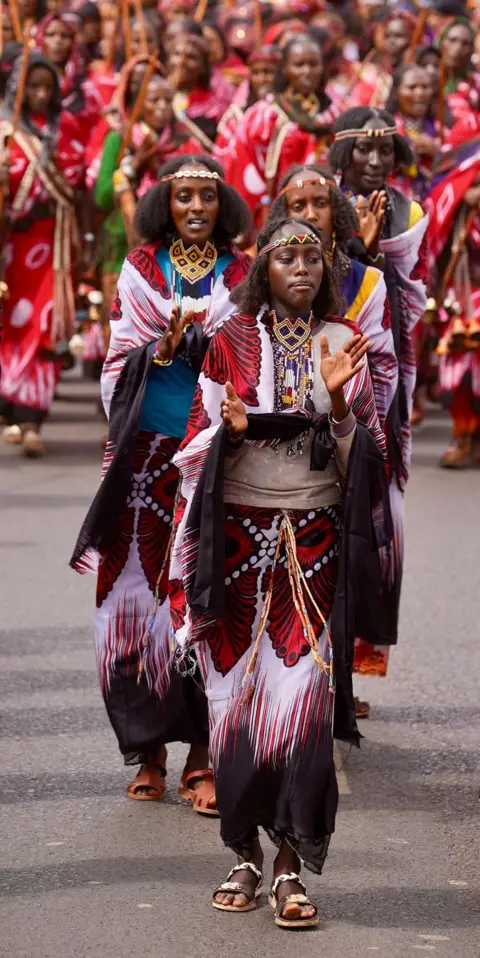
[BBC]
In this pastoralist society women are excluded from holding the top power of Abbaa Gadaa, sitting on the council of elders or being initiated into the system as a child.
But their important role can be seen during the festival as they build all the accommodation for those staying for the week – and prepare all the food.
And the unique Gada system of governance, which was added to the UN’s cultural heritage list in 2016, allows for them to attend regular community meetings and to voice their opinions to the Abbaa Gadaa.
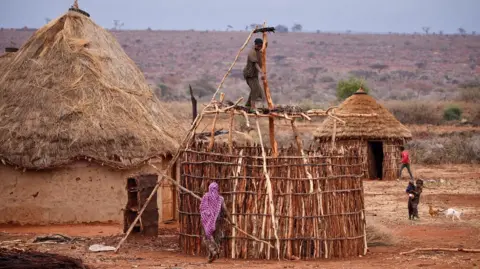
Gada membership is only open to boys whose fathers are already members – young initiates have their heads shaven at the crown to make their rank clear.
The smaller the circle, the older he is.

As the global cultural body UNESCO reports, oral historians teach young initiates about “history, laws, rituals, time reckoning, cosmology, myths, rules of conduct, and the function of the Gada system”.
Training for boys begins as young as eight years old. Later, they will be assessed for their potential as future leaders.
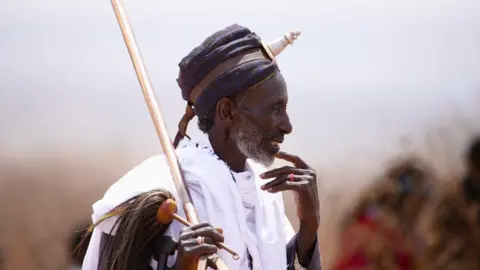
As they grow up, tests include walking long distances barefoot, slaughtering cattle efficiently and showing kindness to fellow initiates.
Headpieces made from cowrie shells are traditionally worn by young trainees. The only other people allowed to wear them are elderly women.
Both groups are revered by Borana community members.

Men aged between 28 and 32 are identified by the ostrich feathers they wear, which are known in the Afaan Oromo language as “baalli”.
Their attendance at the Gada ceremony is an opportunity to learn, prepare and bond as it is already known who the Abbaa Gadaa from this age group will be taking power in 2033.

The main event at the recent Gada ceremony was the handover of power, from the outgoing 48-year-old Abbaa Gadaa to his younger successor.
Well-wishers crossed the border from Kenya and others travelled from as far as Ethiopia’s capital, Addis Ababa, to witness the spectacle. The governor of Kenya’s Marsabit county was among the honoured guests.
Thirty-seven-year-old Guyo Boru Guyo, seen here holding a spear, was chosen to lead because he impressed the council of elders during his teenage years.
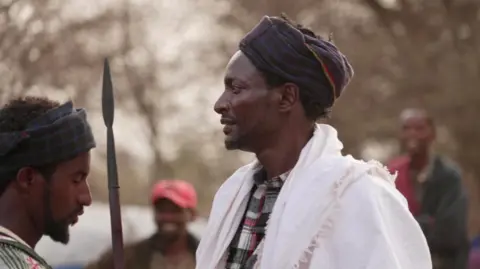
[BBC]
He becomes the 72nd Abbaa Gadaa and will now oversee the Borana community across borders – in southern Ethiopia and north-western Kenya.
As their top diplomat, he will also be responsible for solving feuds that rear their heads for pastoralists. These often involve cattle raiding and disputes over access to water in this drought-prone region.
During his eight years at the helm, his successor will finish his training to take on the job in continuation of this generations-old tradition.
[BBC]
-

 Editorial6 days ago
Editorial6 days agoRanil roasted in London
-

 Latest News7 days ago
Latest News7 days agoS. Thomas’ beat Royal by five wickets in the 146th Battle of the Blues
-

 Features6 days ago
Features6 days agoThe JVP insurrection of 1971 as I saw it as GA Ampara
-

 Opinion5 days ago
Opinion5 days agoInsulting SL armed forces
-
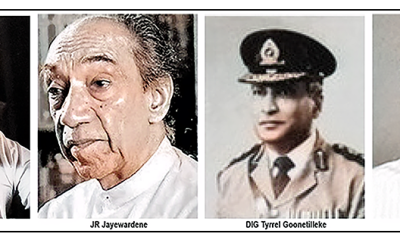
 Features6 days ago
Features6 days agoMr. JR Jayewardene’s passport
-

 News3 days ago
News3 days agoAlfred Duraiappa’s relative killed in Canada shooting
-

 Features6 days ago
Features6 days agoAs superpower America falls into chaos, being small is beautiful for Sri Lanka
-

 Opinion6 days ago
Opinion6 days agoBeyond Victory: sportsmanship thrives at Moratuwa Big Match











